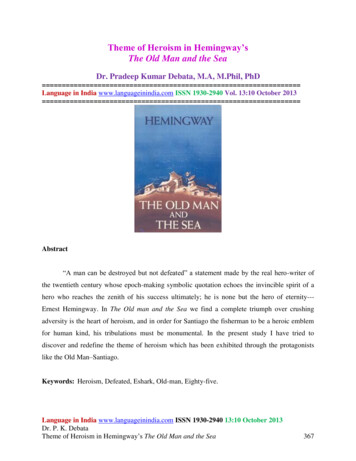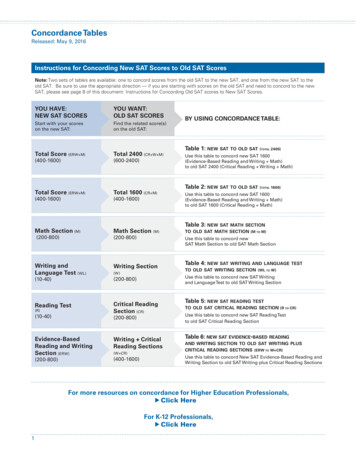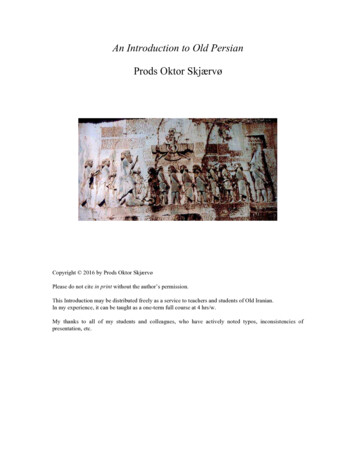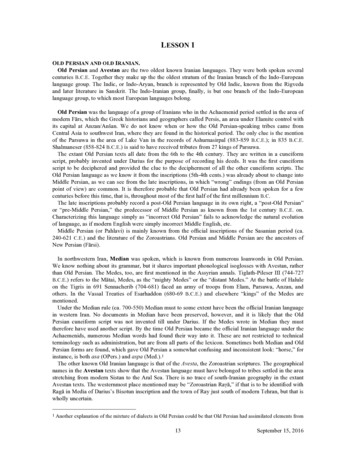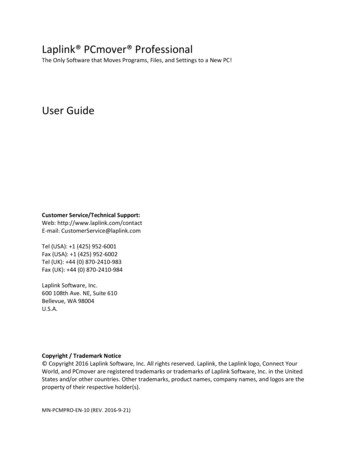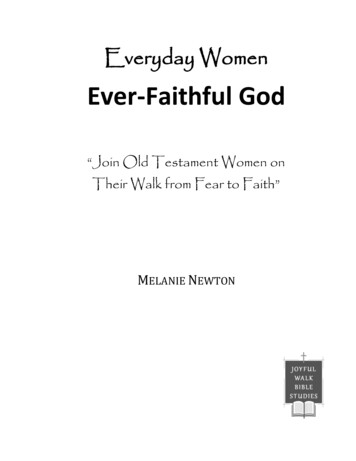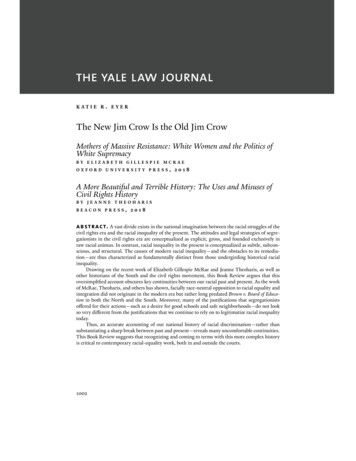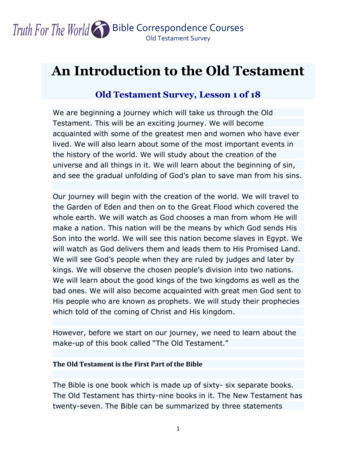
Transcription
Bible Correspondence CoursesOld Testament SurveyAn Introduction to the Old TestamentOld Testament Survey, Lesson 1 of 18We are beginning a journey which will take us through the OldTestament. This will be an exciting journey. We will becomeacquainted with some of the greatest men and women who have everlived. We will also learn about some of the most important events inthe history of the world. We will study about the creation of theuniverse and all things in it. We will learn about the beginning of sin,and see the gradual unfolding of God’s plan to save man from his sins.Our journey will begin with the creation of the world. We will travel tothe Garden of Eden and then on to the Great Flood which covered thewhole earth. We will watch as God chooses a man from whom He willmake a nation. This nation will be the means by which God sends HisSon into the world. We will see this nation become slaves in Egypt. Wewill watch as God delivers them and leads them to His Promised Land.We will see God’s people when they are ruled by judges and later bykings. We will observe the chosen people’s division into two nations.We will learn about the good kings of the two kingdoms as well as thebad ones. We will also become acquainted with great men God sent toHis people who are known as prophets. We will study their prophecieswhich told of the coming of Christ and His kingdom.However, before we start on our journey, we need to learn about themake-up of this book called “The Old Testament.”The Old Testament is the First Part of the BibleThe Bible is one book which is made up of sixty- six separate books.The Old Testament has thirty-nine books in it. The New Testament hastwenty-seven. The Bible can be summarized by three statements1
Bible Correspondence CoursesOld Testament Surveyconcerning Jesus Christ, its chief character: (1) “Someone is coming”is the message of the Old Testament; (2) “Someone has come” is themessage of the first four books of the New Testament; (3) “Someoneis coming again” is the message of the rest of the New Testament.The Old Testament can also be divided into five sections according tothe content of the books. The first section is known as “The Law.”These are the five books from Genesis to Deuteronomy. They are alsocalled “The Pentateuch,” which means “five volumes.” The Books ofLaw were written by Moses.The next section of the Old Testament is called “The Books of History.”These twelve books begin with Israel’s conquest of the Promised Land.They tell about the judges, kings, priests, and prophets of God’speople. The Books of History are Joshua, Judges, Ruth, First andSecond Samuel, First and Second Kings, First and Second Chronicles,Ezra, Nehemiah and Esther.The next section of the Old Testament is known as “Poetry.”Sometimes it is also called “Wisdom Literature” because of the manywise sayings found in it. This section begins with the book of Job andincludes Psalms, Proverbs, Ecclesiastes and Song of Solomon. Thereare five books of Poetry and Wisdom Literature.The last part of the Old Testament contains the inspired writings ofprophets of God. There are seventeen books of prophecy. These areusually divided into two sections: (1) Five books known as “MajorProphets;” and (2) Twelve books known as “Minor Prophets.” Thebooks of the Major Prophets are not more important than those of theMinor Prophets. They are simply greater in length.The Old Testament is Inspired by GodThe word “inspired” means “God breathed.” This shows that the Biblecame from God not from men. The Holy Spirit revealed God’s word tomen whom He had selected. These men wrote the books of the Old2
Bible Correspondence CoursesOld Testament Surveyand New Testaments. God used thirty-two different men to write thebooks of the Old Testament. From Moses, who wrote the first book, toMalachi, who wrote the last book, was 1,000 years. Yet, all the booksfit perfectly together. This shows there was one Source from which themessage of all of them came.The New Testament claims the Old Testament was given by inspiration(Please read 2 Timothy 3:16,17). The Apostle Peter wrote: “knowing thisfirst, that no prophecy of scripture is of private interpretation. For no prophecy evercame by the will of man: but men spake from God, being moved by the Holy Spirit” (2Peter 1:20,21).The Old Testament also claims it was given by inspiration of God.David, who wrote many of the Psalms, said: “The Spirit of Jehovah spake byme, And his word was upon my tongue” (2 Samuel 23:2). Jeremiah claimed thatGod gave him his message: “Then Jehovah put forth his hand, and touched mymouth; and Jehovah said unto me, Behold, I have put my words in thy mouth”(Jeremiah 1:9).Why Should We Study the Old Testament Today?The Old Testament was God’s law for Israel. The New Testament isGod’s law for all men today. In the Old Testament, God foretold thetime when He would make a new covenant or testament ( Pleaseread Jeremiah 31:31-34 and Hebrews 8:6-13). The New Testamentbecame God’s law following the death of Jesus Christ for our sins andthe beginning of the church of Christ on Pentecost Day (Acts 2). Sincewe live under the New Testament today, some have wondered why weshould study the Old Testament.First, we should study the Old Testament because the New Testamentis built upon its foundation. A man named Augustine said: “The OldTestament is the New Testament concealed. The New Testament is theOld Testament revealed.” The promises and prophecies of the OldTestament are fulfilled in the New Testament. Neither one would be3
Bible Correspondence CoursesOld Testament Surveycomplete without the other.Second, we should study the Old Testament because we can learnmuch about how God deals with men. We serve the same God thepeople of Israel served. His law has changed, but He is still the same(Malachi 3:6). We learn from the Old Testament that God’s spiritualblessings are only given to those who obey Him. We see that therighteous are rewarded and the wicked are punished. We learn thatGod is both just and merciful (Romans 11:22).Third, we can be encouraged by the lives of the great men and womenof faith. Paul said of the Old Testament: “For whatsoever things were writtenaforetime were written for our learning, that through patience and through comfortof the scriptures we might have hope” (Romans 15:4). We will never understandfully the New Testament unless we understand the Old Testament.Other Facts About the Old TestamentThere are some other things about the Old Testament which are veryhelpful to know. First, the Old Testament was first written in theHebrew language. Small portions were also written in Aramaic, alanguage which is similar to Hebrew.Second, the Old Testament covers several thousand years of history.It begins with the creation of the world and ends with the prophetMalachi who lived about 400 years before Jesus.Third, God’s revelation to man can be divided into three time periods:(1) The Patriarchal Age which lasted from creation to the giving of theLaw of Moses to Israel at Mt. Sinai; (2) The Mosaic Age which lastedfrom the giving of the Law at Mt. Sinai to the death of Jesus Christ onthe cross; (3) The Christian Age which began with the cross of Christand will continue until the Lord comes again. The Old Testamentcovers the first two ages. The New Testament covers the last age.4
Bible Correspondence CoursesOld Testament SurveyGenesis: The Book of BeginningsOld Testament Survey, Lesson 2 of 18The first book of the Old Testament is called “Genesis.” “Genesis”means “beginning” or “origin.” Thus, the book of Genesis is the bookwhich tells about the beginning of all things. In Genesis we learn thatGod was “in the beginning” (1:1). He existed before all things for He isthe Creator of all things.Some of the “beginnings” recorded in Genesis are: (1) the heavensand the earth; (2) all plant, animal, and human life; (3) all races,nations, and languages; (4) agriculture, music, arts and crafts; (5)marriage and the family.The beginning of God’s plan to save man is also recorded in Genesis.This plan includes the beginning of (1) sin; (2) sacrifice; (3)prophecies of the coming Savior; (4) the nation through which theSavior would come; (5) the tribe from which the Savior would come.Genesis is the foundation of the five Books of the Law. It is also thefoundation of the entire Old Testament. In fact, it is really thefoundation of all the Bible. If the book of Genesis were removed fromthe Bible, the rest of the Bible would have no meaning. We would notbe able to understand the plan of salvation, or the need for it.Genesis Refutes the Theory of EvolutionEvolution denies that God created all things. It says that mangradually developed from lower forms of life. Genesis, however,teaches that God created man fully formed. Also, it teaches that manwas created in the image of God (1:27). God created man, as well asall animal and plant life, with the ability to bring forth after their ownkind (1:11,12,21,24,25). Evolution says that everything evolved overthousands of millions of years. Genesis, however, clearly teaches thatGod created the world and everything in it in six actual days (1:31;5
Bible Correspondence CoursesOld Testament Survey2:1; Exodus 20:11).The First Eleven Chapters Are the CornerstoneJust as the cornerstone is essential to the foundation of a building, thefirst eleven chapters of Genesis are essential to the whole book. TheNew Testament supports the truthfulness of Genesis, chapters 1-11. Ifthese chapters are not true, then we cannot believe the NewTestament. Jesus spoke of the beginning of the creation and the originof marriage just as they are taught in Genesis (Matthew 19:3-9; Mark10:6-10). Genesis tells of Eve’s being tempted. Paul confirms thisin Second Corinthians 11:3. Paul said Adam was the first man in FirstCorinthians 15:45 just as Genesis teaches. Peter mentions the accountof Noah and the Great Flood which is found in Genesis (1 Peter3:20,21; 2 Peter 3:5,6).The fall of man into sin is recorded in the third chapter of Genesis. Thevery first promise of the coming Savior is given in verse 15. TheSavior, who would bruise the head of Satan, would come of the seedof the woman. This is a promise of the virgin birth of Christ. It is alsoa promise of His victory over Satan by dying on the cross and risingfrom the dead.Chapter 4 tells of the murder of righteous Abel by his brother Cain.Chapter 5 records the genealogy (family history) of Seth. Jesus cameinto the world through this family. Chapters 6-8 tell of the greatworldwide flood which was sent as a punishment for man’s sins. OnlyNoah and his family found grace in the eyes of God. They were savedwhen they obeyed God by building an ark (ship). Chapter 11 tells ofthe tower of Babel where the many different human languages began.The human family history of Christ begins in Genesis. The importantlinks in it are Adam, Seth, Noah, Shem, and Abraham.Abraham’s History is Recorded in Chapters 12-256
Bible Correspondence CoursesOld Testament SurveyAbraham was selected by God to begin the chosen nation throughwhich the Savior would come into the world. He left his home in Ur atGod’s request. He went to the land of Canaan which God promised togive to his seed. He and his nephew Lot separated because they hadso many cattle there was not room for them to live together. LaterAbraham rescued Lot when he was captured in war. On the way homehe was met by Melchizedek, the king of Salem (Jerusalem). Abrahamgave gifts to him. Melchizedek blessed Abraham.God had promised Abraham that in his seed would come the One whowould bless all the earth. However, Abraham and Sarah had nochildren. Sarah suggested Abraham have a son by her maid Hagar.This showed her lack of faith. Ishmael was born to Hagar andAbraham, but God did not accept him as the Promised Seed throughwhom the nation would come. When Abraham and Sarah were veryold, their faith had become stronger. God then gave them a son whowas named Isaac. Abraham’s strong faith in God was shown when hewas willing to offer Isaac as a sacrifice when God commanded it(Genesis 22; Hebrews 11:17-19).Sarah died at the age of 127 years. She is the only woman whose ageis recorded in the Bible. Abraham lived to be 175 years old. He wasburied in the Cave of Machpelah beside Sarah.The History of Isaac Is Recorded in Chapters 25-27Isaac’s wife, Rebekah, gave birth to twin sons. They were named Esauand Jacob. Because Esau was born first, the family headship shouldhave passed to him. However, he was unworthy of it (Hebrews12:16,17). Esau sold his birthright to Jacob for a bowl of lentils(beans). Jacob deceived his father Isaac into giving him the blessing.This made Jacob the head of the family. It meant that God’s promisewould be fulfilled through Jacob’s children.7
Bible Correspondence CoursesOld Testament SurveyThe History of Jacob is Recorded in Chapters 28-50Jacob went to Padan-aram for a wife. On the way he stopped at Bethelwhere he had a dream of a ladder into heaven. Here he made a vowto God. In Padan-aram, Jacob fell in love with Laban’s daughter,Rachel. He agreed to work for her for seven years. Laban tricked Jacoband gave him Leah instead. Jacob then worked another seven yearsfor Rachel.Jacob and his two wives, Leah and Rachel, and their maids, Bilhah andZilpah, had a family of twelve sons and one daughter. The twelve sonsbecame the heads of the twelve tribes which formed the nation ofIsrael. Judah, the fourth born son, became the one through whoseseed Christ came (Genesis 49:10).The family line of Christ is now: Adam, Seth, Noah, Shem, Abraham,Isaac, Jacob, and Judah.The Story of Joseph is Recorded in Chapters 37 to 50Joseph was Jacob’s favorite son. He unwisely showed this by givingJoseph a beautiful coat. This made his brothers jealous. They sold himinto slavery in Egypt. Joseph was a righteous young man. Even thoughhe had many troubles, God blessed him. Eventually he became theruler of all Egypt, second only to Pharaoh. God used this to save Hispeople from a great famine which came all over the world. Josephbrought Jacob and his brothers and their families to Egypt where therewas food. Jacob died in Egypt and was taken back to Canaan to beburied. When Joseph died in Egypt at the age of 110, he knew Godwould return His people to the Promised Land. Therefore, he left hisinstructions that his bones should be carried there and buried.Joseph’s life shows how God works providentially. God can overrule inthe affairs of men to bring about His will. He did this in order to placeJoseph in the position in Egypt where he could save His people fromstarving. God still works providentially today. We cannot always see or8
Bible Correspondence CoursesOld Testament Surveyunderstand it, but God works in the lives of His people to bring aboutwhat is best for them (Romans 8:28).9
Bible Correspondence CoursesOld Testament SurveyExodus: Escape from EgyptOld Testament Survey, Lesson 3 of 18The second book of the Pentateuch is called Exodus. “Exodus” means“going out.” This book tells how Jacob’s family grew into a nation inEgypt. It tells how the Egyptians became afraid of God’s people andmade slaves of them. Exodus also reveals how God delivered Hispeople from Egypt.Genesis recorded the beginning of God’s chosen family through whichthe Savior would come into the world. Exodus continues their historyby showing how they actually grew from a family into a nation. Exodusdeals with two themes: (1) Deliverance; (2) Law.Moses is the chief character in the book of Exodus. He is also one ofthe greatest leaders who has ever lived. His lifetime of 120 years canbe divided into three periods: (1) forty years as a prince in Egypt; (2)forty years in the wilderness of Midian as a shepherd; (3) forty yearsas the leader of God’s people.Moses is the human author of the book of Exodus. The book itselfclaims Moses as its author (Exodus 17:14; 24:4). Jesus said Moseswrote Exodus (Mark 1:44; John 7:19-23). The Apostle Paul also gaveMoses credit for writing Exodus (Acts 26:22,23). From ancient timesthe Jews have believed Moses wrote Exodus. It was written during thetime Israel was in the desert. This was sometime between 1500 B.C.and 1400 B.C.Genesis and Exodus are very closely connected. Genesis closes withIsrael in Egypt. Exodus begins at that point and continues Israel’shistory. Exodus covers a period of about 360 years. It begins with thedeath of Joseph and continues to the building of the tabernacle at Mt.Sinai.Israel Escapes from Egypt (Chapters 1-18)10
Bible Correspondence CoursesOld Testament SurveyThe people of Israel multiplied rapidly in Egypt. After a time, a newPharaoh came to the throne. He did not know about Joseph and howhe had saved Egypt from famine. He feared the people of Israelbecause of their growing numbers. Therefore, he made them slaves.The people of Israel were treated very badly. However, the more theywere afflicted, the faster they grew. Pharaoh commanded themidwives to kill the male babies, but they did not do it. Finally, inorder to stop Israel from growing so rapidly, Pharaoh commanded thatall male babies should be cast into the river.Moses was born during this time. His parents feared God. Theyrefused to kill their baby. They hid him for three months. Then theymade a little ark (boat) of bulrushes and put Moses in the river nearthe place that Pharaoh’s daughter came to bathe. Miriam, Moses’ oldersister, watched nearby. Pharaoh’s daughter found the baby. At herrequest Miriam called Jochebed, Moses’ mother, to be his nurse.Therefore, Moses was brought up as a prince in the palace of Pharaoh.He was cared for by his own mother who must have told him aboutthe true God and his people.When Moses became a man, he gave up the pleasures of Egypt. Hechose to be a slave with his own people instead of a prince (Pleaseread Hebrews 11:24-26). One day he saw an Egyptian beating anIsraelite. He defended the Israelite by killing the Egyptian. When thisbecame known, Moses fled from Egypt. He went to the land of Midianwhere he met Reuel (also called Jethro), a priest of God. He marriedReuel’s daughter Zipporah and became the father of two sons.After forty years the Lord spoke to Moses out of a burning bush. Hetold him that he must deliver His people from bondage. Moses mademany excuses, but God answered them all. Aaron, Moses’ elderbrother, was sent to be Moses’ spokesman. Moses asked Pharaoh tolet Israel go, but the wicked ruler refused. God sent a series of tenplagues upon the land of Egypt to persuade Pharaoh to free Hispeople. First, the water was turned to blood, but Pharaoh hardened his11
Bible Correspondence CoursesOld Testament Surveyheart. Then the land was filled with frogs, but Pharaoh’s heart was stillhard. After this the dust of the land become lice. Still Pharaoh refusedto let the people go. God then sent a plague of flies upon Egypt. Onlythe Egyptians were affected. The land of Goshen where Israel livedwas not touched by the flies. This time Pharaoh said Israel could go.Then he changed his mind and refused. Next, God sent a murrain(sickness) upon all the cattle, sheep, camels, horses, and donkeys ofEgypt so that they died. Pharaoh’s heart was hardened once again.After this God sent boils (sores) upon the Egyptians. The Bible saysGod hardened Pharaoh’s heart. He did this by giving him a commandwhich Pharaoh refused to obey. Then God sent hail (ice) upon theland. All the crops were destroyed. Pharaoh confessed he had sinned.However, when God took away the hail, he hardened his heart again.After this God sent a plague of locusts. Again Pharaoh admitted he hadsinned. Then he changed his mind and would not let Israel go. Thenext plague God sent was thick darkness over all of Egypt. This lastedfor three days. Still Pharaoh would not let Israel go.Finally, God sent the last plague. All the firstborn of both men andanimals would die. Israel, however, was spared. They were told to killa male lamb. It had to be one year old. It also had to be without spotor blemish. It was to be eaten the night God destroyed all thefirstborn. The blood of the lamb was put on the doorposts of thehouses where God’s people lived. If the blood was seen on the door,God passed over them and the firstborn lived. If the blood was notapplied, the firstborn died. This was the beginning of the Feast of thePassover. Jesus Christ is the passover sacrifice for us today (1Corinthians 5:7). If His blood has been applied to us, we will be saved.If not, we will be lost forever.That night Pharaoh let the people go. Israel marched to the Red Sea.Pharaoh changed his mind and sent his army after Israel. The sea wasin front. The Egyptian army was behind. Moses raised his rod and Godparted the waters. Israel crossed over on dry land. When Pharaoh’sarmy tried to follow, the waters closed over them. They were all12
Bible Correspondence CoursesOld Testament Surveydrowned.In the desert God provided for His people by giving them manna toeat. He gave them water from a rock. He also gave them victory overthe Amalekites who attacked them.The Giving of the Law at Mt. Sinai (Chapters 19-24)The Israelites camped at Mt. Sinai where God had appeared to Mosesin the burning bush. God called Moses up into the mountain. Moseswas alone with God for forty days. God revealed His Law for thepeople of Israel to Moses during this time. The heart of this Law is theten commandments. The first four commandments concern man’sresponsibility to God. The last six concern man’s responsibility to hisfellow man. These commandments are found in Exodus 20:1-17. TheLaw given at Sinai was God’s Law for Israel. It continued until Christdied on the cross (Colossians 2:14). Now we live under the Law ofChrist, which is also called “the New Testament” (Hebrew 7:12; 8:613).The Building of the Tabernacle (chapters 25-40)The tabernacle was a tent made up of two rooms. These rooms wereknown as the holy place and the most holy place. It was surroundedby an outer court. Here the priests offered up sacrifices to God onbehalf of the people. The tabernacle was a tent which could be takendown and moved whenever Israel moved. It was built according to thepattern (plan) God gave to Moses (Exodus 25:9, 40).As God delivered Israel from slavery in Egypt, so today He delivers usfrom slavery to sin. Moses was Israel’s Lawgiver and Deliverer fromphysical bondage. Jesus Christ is our Lawgiver and Deliverer fromspiritual bondage.13
Bible Correspondence CoursesOld Testament SurveyLeviticus, Numbers, and DeuteronomyOld Testament Survey, Lesson 4 of 18The last three books of the Pentateuch are Leviticus, Numbers andDeuteronomy. Moses was the human author of these books also.Twenty of the chapters of Leviticus begin with the statement: “And theLord spoke to Moses, saying.” “The Lord spoke to Moses” appears forty times inthe book of Numbers. Deuteronomy clearly claims Moses as its author(Deuteronomy 1:1,5; 4:44,45; 31:24-26). Jesus said the Law (thefirst five books of the Old Testament) was written by Moses (John5:45-47). However, the last chapter of Deuteronomy may have beenwritten by Joshua for it tells of Moses’ death.Leviticus was written at Mt. Sinai. Numbers probably was written nearthe end of the wandering in the desert. Deuteronomy would have beenwritten shortly before Moses’ death (Deuteronomy 1:5; Numbers36:13).Leviticus: The Way of HolinessLeviticus served as a guide for the priests and Levites. It containsinstructions about sacrifices, offerings and tabernacle worship. It alsoshows that sinful men can approach a sinless God by means ofsacrifice (Isaiah 59:1,2; Romans 6:23; Hebrews 9:22;10:4). Leviticusemphasizes that blood is essential to atonement for sins (Leviticus17:11). The two key words in Leviticus are: (1) holiness and; (2)atonement. The book is named for the Levites, the tribe from whichthe priests came.There are five major offerings by which Israel could maintain holinessbefore God. They are: (1) Burnt offerings which showed completededication to God; (2) Meal offerings which showed gratitude to Godfor His blessings; (3) Peace offerings which showed communion orfellowship with God; (4) Sin offerings which atoned for sins. Sin14
Bible Correspondence CoursesOld Testament Surveyofferings were a type of Christ’s sin offering for us; (5) Trespassofferings for specific acts of wrongdoing.Numbers: Wandering in the WildernessThis book is called “Numbers” because all the males who were oldenough to serve in the army were numbered. This was done at Mt.Sinai and later as they prepared to enter Canaan. Numbers covers thetime of Israel’s wandering in the desert from Mt. Sinai to the Plains ofMoab. This was about 38 years. The book can be divided into fivesections.The first section records the preparation to begin the journey from MtSinai (Numbers 1:10 - 10:10). A count was taken which showed therewere 603,550 men old enough to serve in the army. The Levites werenot included. Instructions for the health of the camp, for tabernacleworship, and for moving the camp were also given.The second section tells of the journey from Sinai to Kadesh-Barnea(Numbers 10:11-14:45). On this journey, several things happened.The people longed for the food in Egypt. They were sent quail by God,but were punished for their sins of murmuring and complaining. AlsoAaron and Miriam rebelled against Moses’ authority. Miriam wasstricken with leprosy as punishment. Perhaps this was because shewas the leader of the rebellion; and being a woman, it was not properfor her to claim such authority. Also twelve spies were sent out fromKadesh-Barnea. They were gone for 40 days. They brought back areport that Canaan was a “land flowing with milk and honey.”However, ten of the twelve spies feared the people of the land. Theylacked faith in God to give them the land. Only Joshua and Calebdisagreed. The people followed the faithless spies. Because the peoplelacked faith, they were sentenced to wander in the desert for fortyyears. Of that generation, only Joshua and Caleb were allowed toenter the Promised Land.15
Bible Correspondence CoursesOld Testament SurveyThe third section covers about 37 years (Numbers 15:1-21:35). It tellsthe events of the journey from Kadesh to the Plains of Moab. Theaccounts of Korah’s rebellion, Moses’ striking the rock instead ofspeaking to it, and the fiery serpents being sent among the people areamong the events recorded. This section ends with the defeat of Og,king of Bashan, and Sihon, king of the Amorites, and the possession oftheir land east of Jordan.The fourth section is the account of Balaam and Balak (Numbers 22:125:18). Balak, king of Moab, hired Balaam to curse Israel. Every timehe tried to curse them, Balaam blessed them instead. Even thoughGod spoke to Balaam through his donkey, he persisted in wrongdoing. When he failed to curse Israel, he taught the Moabite women toseduce the men of Israel to engage in idolatry and fornication. Heknew this would bring God’s anger upon Israel (cf. 2 Peter2:15,16; Jude 11; Revelation 2:14).The last section tells of the final preparation to enter the PromisedLand (Numbers 26:1-36:13). Males of military age were againcounted. The number was 601,730. The cities of the Levites were setaside. Cities of refuge were also chosen. One who killed anotherperson accidentally could seek safety in such a city until his case washeard by the elders of Israel.Deuteronomy: Moses’ Farewell AddressWhen this book began, Israel was camped in the Plains of Moab, eastof Jordan. Moses had served God for forty years. Joshua was selectedto be the new leader. Moses gave his final speech to Israel. He statedagain the Law God gave to Israel at Mt. Sinai. He added warnings ofwhat would happen if the Law is disobeyed. He told of the blessingsthat will come if it is obeyed.The book of Deuteronomy gets its name from two words: (1) deuteros- two or second; (2) nomos - law. Deuteronomy is a second giving of16
Bible Correspondence CoursesOld Testament Surveythe law. It is a repeat of the Law given at Mt. Sinai. The purpose ofDeuteronomy was to prepare Israel for entering Canaan to be God’schosen nation.The ten commandments are repeated in Deuteronomy, chapter five.Moses made it very clear that they were given only to the nation ofIsrael. The “Great Commandment” in the Law is stated in chapter6:4,5: “Hear, O Israel: The LORD our God is one LORD: And thou shalt love the LORDthy God with all thine heart, and with all thy soul, and with all thymight.” (cf. Matthew 22:35-40). Many warnings are given that God’sLaw must not be changed in any way ( Deuteronomy 4:2; 12:32). Inchapter eighteen, Moses gave the test of a prophet. If one’s prophecydoes not come to pass, he is a false prophet. He also speaks of aProphet who would one day be sent by God. This is a reference to thecoming of Christ ( Acts 3:22, 23).The death of Moses is recorded in chapter 34. Moses was notpermitted to enter the Promised Land because of his sin when hestruck the rock (Numbers 20). God permitted him, however, to climbMt. Nebo to the top of a peak called Pisgah where he could see thewhole land. Then Moses died in the land of Moab. He was buried byGod. No man knows the place. Moses was 120 years old at his death,but he was still a strong, able man. “His eye was not dim, nor his natural forceabated.” He had served well in bringing God’s people to the PromisedLand. Now, Joshua, a younger man, who had been his assistant, wouldlead the nation in taking Canaan.An important teaching found in Leviticus, Numbers, and Deuteronomyis that of obedience. God’s blessings are only given as a result ofobedience. He always punishes disobedience if it is not repented of.We have completed our study of the first section of the OldTestament. We have traveled through the major events of the Booksof Law. We have now come to the Jordan River and are ready to enterthe Promised Land.17
Bible Correspondence CoursesOld Testament SurveyJoshua: T
became God’s law following the death of Jesus Christ for our sins and the beginning of the church of Christ on Pentecost Day (Acts 2). Since we live under the New Testament today, some have wondered why we should study the Old Testament. First, we should study the Old Testament


